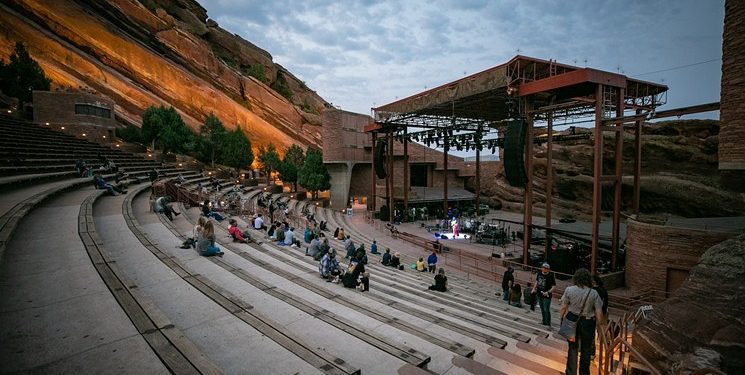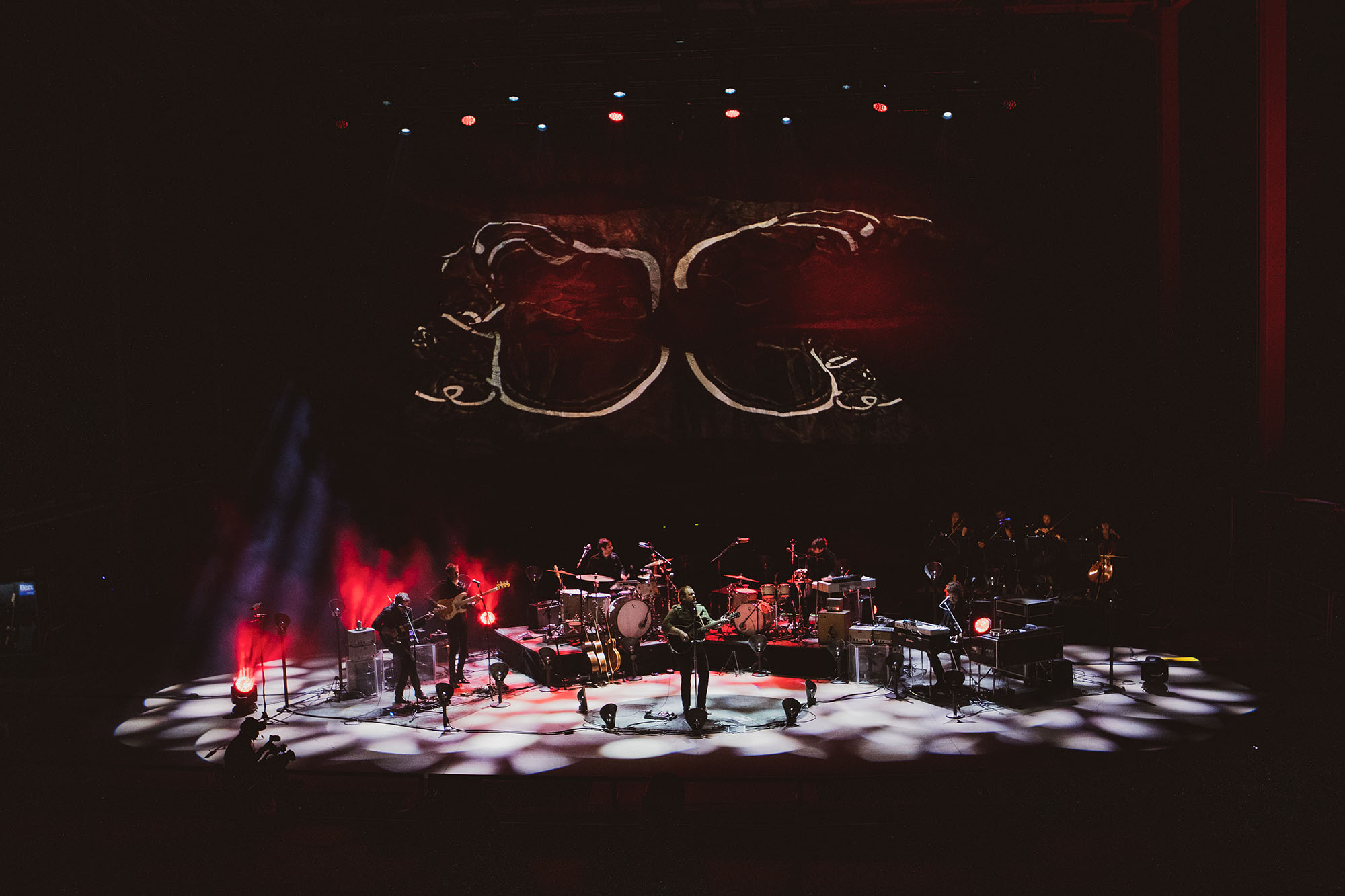Brown Note Productions Provides Audio for Nathaniel Rateliff COVID-Safe Shows at Red Rocks Amphitheatre
(Photo: Aaron Thackeray)
Brown Note Productions supported Covid-safe shows at Colorado’s Red Rocks Amphitheatre. So far, 2020 has been a sadly recurring tale. Popular Americana, folk and R&B artist Nathaniel Rateliff is highly regarded by both critics and fans alike, both as a solo performer as well as with his Nathaniel Rateliff and The Night Sweats high-energy R&B band. To promote his current And It’s Still Alright solo album, Rateliff kicked off a tour in March at the State Theatre in Minneapolis, MN. And after that tour, he’d be opening for Bob Dylan’s summer tour. Everything seemed great, until mid-March, when just a few shows into Rateliff’s tour, Covid-19 venue closures put the kibosh on that scenario.
Undaunted, Rateliff went back into the studio, while waiting to continue live performances. Eager to get back out, the Denver-based artist arranged a string of socially distanced shows Sept. 15-21 at the famed Red Rocks Amphitheatre, with proceeds to benefit The Marigold Project, his Colorado-based nonprofit dedicated to economic, social and racial justice.
The main issue was Colorado’s limit of 175 persons per show. With the high rental costs for this 9,525-capacity venue, the economics for small audience shows didn’t make sense. However, as this was a benefit, an affordable rental arrangement was worked out, and the shows — which besides the limited attendance, also included drive-in style FM radio feeds to additional fans in the parking lot and multi-camera video shoots for later release.
Handling audio for the series was the Thornton, CO-based Brown Note Productions (who frequently provides production services at Red Rocks), and they brought in a d&b audiotechnik GSL line array system for the shows.
We chatted with Rateliff’s longtime studio and FOH engineer Jamie Mefford about the Red Rocks series. “Nathaniel loves playing live and wanted to do something,” Mefford explains. “When the tour earlier in the year was cancelled, he was really bummed and he wanted to do it one more time with full production and film it. He does a lot of stuff with The Night Sweats, and this was more folk-oriented and a more intimate show he wanted to bring home, play for hometown fans and film so the world could see it in its full glory, because the next tour will be with The Night Sweats.”
Lots of Changes
The Red Rocks shows featured Rateliff with the players in his core Denver band, some of whom are in The Night Sweats. For a different flavor, Rateliff swapped the horn section for a four-piece string section and added another drummer, making it totally different from his usual configuration.
There were also a few shifts in personnel. The band’s production manager, David Gleeson, usually mixes monitors, but he was in Scotland and couldn’t make the show. For monitors, Mefford turned to touring veteran Xandy Whitesel, the FOH engineer for indie folk band Bon Iver, who sometimes fills in on FOH for Rateliff when Mefford is unavailable.
In terms of FOH consoles, Mefford switched from the Avid platform to a Yamaha RIVAGE PM10. “I’m really happy with it. The PM10 is outstanding, and don’t think I am ever going to look back. I’m mostly mixing in the box, but I also carry a spring reverb. On this last record, Nathaniel recorded through an AKG spring reverb and wanted to capture that sound live, so we bought a couple Benson Amps spring reverb units, which sound great. I also carry a Bricasti reverb, which sounds amazing and does things that no plug-in can duplicate. I usually tour with a Rupert Neve Designs Master Buss Compressor and some Distressors I have in my rack, but I didn’t need them this time — the onboard Yamaha reverbs and the PM10’s Rupert Neve EQs sound great. We do a lot of fly-in dates, and I wanted to use as little extra gear as I could.”
Capturing That Rateliff Sound
Rateliff has a great voice, so I expected some exotic stage mic, but he sings into a Shure SM58. “We tried a lot of vocal mics and kept coming back to the sound of the SM58. It just works for his voice,” Mefford explains. To capture Nathaniel’s acoustic guitar, Mefford likes having options. “I have three choices. I have a Radial direct box, an AEA ribbon mic on his acoustic guitar amp and an AEA KU5A cardioid ribbon mic clipped to his mic stand. We carry six or seven AEA ribbon mics on tour and use them every day. They’re really reliable and have held up over three years of flying and touring and festival stages — they’re bombproof!”
The System
For the shows, Brown Note Productions provided a d&b audiotechnik GSL P.A. (see gear list above for details) as well as an audio console package and RF for the drive-in feeds.
“We’re running a full d&b audiotechnik P.A., but we just used four or five fewer boxes per side than normal. It worked out really well. Actually, when we first put these shows together, I figured we’d just put in a really small P.A., but we decided to just hang the whole thing and a couple of other bands used the same system after we finished our series,” Mefford notes.
“Brown Note was one of the early adopters of the system, and I mixed another show at Red Rocks with it a couple years ago. I also mixed a GSL show at on the main stage at South by Southwest about two years ago. I really liked it at Red Rocks this time, especially with a recording truck there. As it’s a more focused, cardioid P.A., there was not as much sound bleeding onto the stage. And this GSL rig is especially smooth. When I walked up through the amphitheater, I couldn’t hear any zones, particularly in a place like Red Rocks, which is so steep. Even when you walk side-to-side to the extreme edges, there is off-axis dropoff, but it’s really smooth. I also like d&b audiotechik’s smaller KSL system, which I’ve mixed on at the Mission Ballroom here in Denver.”
Into the Mix
“There was a limit of about 200 people in the amphitheater each night,” which, according to Mefford, “was both kind of cool and at the same time, kind of weird. When mixing at Red Rocks, you’re pushing your mix way up the hill and there are no delays. I live in the area, so I’ve mixed a lot of shows at Red Rocks, where you usually feel like you’re are blowing yourself out in terms of volume to reach the people seated way up at the top, because the FOH position is so close to the stage. But this time, most of the audience was sitting in the front and around the mix position. That was nice for me, because it’s the first time I’ve mixed at Red Rocks where everyone in the audience was hearing the same level as me.”
Speaking of levels, although everyone in the band is on in-ears, “the stage volume can get pretty loud,” says Mefford, “yet this folk version is a very dynamic show. It goes from very small, with just guitar and vocal — to giant, and with the strings and everything, it can be as loud as The Night Sweats, which is all rock ‘n’ roll to the wall. So it can be challenging to mix.”
Despite that, Mefford kept the SPLs in check. “At Red Rocks, I slowly turned up the level as the show progressed. I was generally in the high 80’s/low 90’s and peaked out a few times over 100 dB. It was a very comfortable level to mix at. And after months of not doing shows, it was get out and turn a P.A. up!”
Nathaniel Rateliff at Red Rocks
Sept. 15-21, 2020
Red Rocks Amphitheatre, Morrison, CO
AUDIO CREW
Sound Company: Brown Note Productions
FOH Engineer: Jamie Mefford
Monitor Engineer: Xandy Whitesel
Systems Engineer: Matt Brown
Production Manager: David Gleeson
Tour Manager: William Pepple
Simulcast Audio Engineer: Tim Seconi
Monitor/Stage Tech: Ryan Sullivan
Audio Techs: Matt Coplon, Josh Hatcher
P.A. GEAR
Main System: (24) d&b audiotechnik GSL8/GSL12 — 12/side
Ground Subs: (6) d&b SL-GSUB — 3/side
Front Fill: (4) d&b Y10P
Amplification: (2) d&b D80 racks
Drive: d&b Array Processing system
FOH GEAR
FOH Consoles: Yamaha RIVAGE PM10
Outboard: Bricasti M7reverb; (2) Benson Amps spring reverbs
RF System: 30W FM Exciter transmitter, FM/HD audio processor
MON GEAR
Monitor Consoles: DiGiCo SD10
Outboard: DiGiCo DigiGrid MGB (recording interface)
Amps: d&b audiotechnik D20
IEM: Shure PSM1000 (14 channels)
Mics: AEA, beyerdynamic, Sennheiser, Shure
DI’s: Radial Engineering J48, Passive Pro



